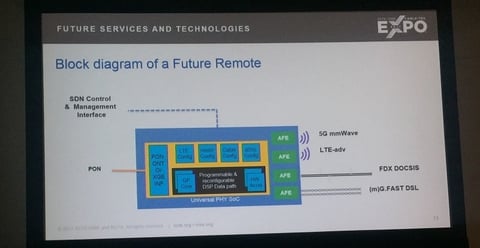DENVER—Cable operators expanding their wireless ambitions may be on to something, according to Bell Labs’ Martin Glapa. At the SCTE Cable-Tec Expo, Glapa said that a fully converged cable and wireless network could create overall cost savings of up to 40%.
“The next step beyond is bringing these two platforms together,” Glapa said during a presentation called “future proofing access networks through wireless/wireline convergence.”
Specifically, Glapa said Bell Labs’ vision for the future relies heavily on the expansion of fiber networks closer to the end user. “All of these networks are pushing fiber to a couple hundred meters to the end user,” he said.
This scenario, he explained, would allow an operator to create an “edge cloud” that would combine a wide range of virtualized technologies including CCAP, RAN, CDN and others. That edge cloud could then deliver a variety of transmission technologies to users, including Gfast, millimeter-wave wireless services, DOCSIS or FTTx.
The key to that setup, Glapa explained, is a universal PHY system-on-a-chip (SoC) that would be programmable and able to handle all of the various output technologies. And that SoC would be able to reduce expenses by applying functions like packet handling, error correction and modulation and mapping to various technologies, from 5G to DOCSIS. “Why not share the processing resources?” Glapa noted.

The result of this setup, Glapa said, would create significant savings. Specifically, he said operators could dynamically move resources across various transmission technologies, spinning up capacity on 5G during the day and then later moving those resources to Full Duplex DOCSIS in the evening, for example.
Glapa said this network design would create overall savings of 40% in dense urban areas, 38% savings in urban areas and 36% savings in suburban areas. Those savings would be derived from savings in unified site development, deployment, network electronics and operating expenses.
Importantly, Glapa said that Bell Labs has been working on a prototype of this setup for years, having initially shown it off at the Mobile World Congress trade show in 2015. He said the company is currently adding LTE and Full Duplex DOCSIS to its prototype, and expects to have a full-blown working design by 2020.
Bell Labs tracks its history back to the 1920s, when several engineering departments within AT&T and Western Electric company were combined. In 1996, AT&T spun off most of Bell Labs to Lucent Technologies, which was subsequently acquired by Alcatel. The resulting Alcatel-Lucent was acquired by Finland’s Nokia in a transaction that was finalized last year.